 资源简介
资源简介
Unit 5 Why do you like pandas
教学目标与要求
话题(Topic):动物园动物(Animals in a zoo)
功能(Functions):1. 能描述各种常见动物(Describe animals)
Pandas are kind of interesting.
Lions are scary.
The dog is really cute.
The cat is kind of boring.
2. 能表达自己对动物的喜好(Express preferences)
A: Why do you like tigers B: Because they’re really cool.
语法(Grammar):1. 能正确使用why, what和where引导的特殊疑问句进行回答(wh- questions and answers)
A: Why do you like pandas
B: Because they’re kind of interesting.
A: Where are lions from B: They’re from South Africa.
A: Why don’t you like tigers B: Because they’re scary.
2. 能正确使用表示性质和品质的形容词(Adjectives of quality)
Your dog is really cute.
He is very smart.
She’s kind of boring.
词汇和常用表达(Words & expressions):
1. 能正确使用以下词汇(Curriculum words):panda, zoo, tiger, elephant, lion, giraffe, animal, kind, Australia, south, Africa, pet, leg, cat, flag, place, water, danger, tree, sleep, save, forget, cut, kill, cute, lazy, smart, beautiful, friendly, shy, down, over
2. 能正确使用以下常用表达(Useful expressions):kind of, South Africa, get lost, one of, be in (great) danger, cut down, (be) made of
3. 能认读下列词汇(Non-curriculum words):koala, scary, symbol, ivory, Thailand, Thai
语音(Pronunciation):1. 掌握以下音素的发音:/s/和/z/,/Iz/,/ts/和/dz/
2. 能划分句子的意群,并在朗读和表达时适当掌握停顿
学习策略(Strategies):
1. 能借助上下文语境猜出部分词汇的含义
2. 能根据词汇的含义、性质、特点等分类记忆单元词汇
3. 能根据阅读语篇内容构建思维导图
4. 能通过各种方式搜集有关动物的信息和资料
文化知识(Culture):
了解世界各地的典型动物
Section A 1 (1a-2d)
一、教学目标:
1. 1) 能掌握以下单词:tiger, elephant, panda, lion, koala, giraffe, cute, lazy, smart,
beautiful, scary, kind, kind of, Australia, south, Africa, South
Africa, pet, leg, cat, sleep
2) 能掌握以下句型:
① What animals do you/does she/ does he like
② Let’s see the …
③ Why do you/does she/ does he want to see …
④ Because they are …
2. ① To observe and describe animals.
② To express preferences
③ To know the implied meaning of some animals
3. 动物和人类都生活在同一地球上,动物是我们的朋友。我们人类应该与动物和
谐相处,共同生存。我们应当学会关爱动物,保护动物。
二、教学重难点
1. 教学重点:
学会描述动物的性格及特点。
2. 教学难点:
表达喜欢某类动物及说明喜欢的原因。
三、教学过程
Teaching objectives
1. To learn to describe animals:
Pandas are kind of interesting.
Lions are scary.
The dog is really cute.
2. To learn to express preferences:
—What animals do you like
—I like koalas.
—Why do you like koalas
—Because they’re very cute.
Ⅰ. Warming up
To create an English environment, the teacher shows the class some pictures of a zoo. And ask some questions about animals:
What is your favorite animal Do you like pandas
Then have them to recall the animals they had learned and write them on the blackboard.
(e.g. animals---sheep, monkey, cat, dog, mouse, cow, duck… )
Ⅱ. Presentation
1. Ask them to talk with their partners about the animals they like using the words they know.
—What animals do you like
—Why do you like…
—Because they’re…
2. Then show the class some pictures of animals and present other animals. And ask them:
What’s this in English
It's a tiger. (Then lion, panda, elephant, koala, giraffe…)
Ss look at the picture and try to remember the new words of the animals.
3. Next, turn to page 25 and finish 1a.
4. Check the answers with the class.
Ⅲ. Listening
Work on 1b.
Tell Ss to listen to the tape and check the animals they hear in 1a.
Play the recording again and fill in the blanks.
1. Pandas are the girl’s favorite animals because they’re _______.
2. The boy likes giraffes because they are _________.
3. The girl thinks koalas are __________.
Ⅳ. Pair work
Watch the video and work in pairs.
What kind of animal do you like very much Why
What kind of animal do you like a little Why
Ⅴ. Work on 1c.
Practice the conversation with your partner. Then make conversations about the other animals in 1a. Use the words in the box.
A: Let’s see the lions.
B: Why do you want to see them
A: Because they’re interesting.
2. Ss practice the conversation using the animal in 1a.
Ⅵ. Listening
1. Work on 2a;
Listen to the conversation carefully. Then write the animals you hear.
Play the recording the first time. Students only listen.
Play the recording a second time. This time students write the animals.
Check the answers.
Explain the adjectives and countries listed on the right.
Play the recording a third time. This time draw a line from the animals to the description words and the countries they are from.
Check the answers.
2. Work on 2b
Listen again and complete the conversation with the words in 2a.
Play the recording for the Ss to listen and write the answers.
Check the answers with the class.
Ⅶ. Pair work on 2c
Talk about the other two animals in 2a with a partner. Do John and Julie like them Do you like them Why or why not
Ⅷ. Role-play
1. Ask Ss to look at the picture in 2d. Then Ss read the conversation in 2d and find the answers to the questions:
1) Does Peter have a pet
2) What can Dingding do
3) Does Jenny’s mother have a pet What’s her name
4) Does Jenny like the cat Why
2. Ss work in pairs and practice the conversation.
3. Let some pairs role-play the conversation.
IX. Language points
1. He can walk on two legs.
walk on… 表示“用某种方式行走”。
e.g. walk on one’s hands 表示“用手倒立行走”
The children like to walk around the house on their hands and knees.
孩子们喜欢手脚并用在房子里爬来爬去。
2. Well, because she’s kind of boring.
kind of有点儿;稍微
e.g. They’re kind of scary. 他们有点可怕。
The pandas are kind of cute. 熊猫有点可爱。
【拓展】
kind作名词意为“种类”
a kind of … 一种…… all kinds of ...,各种各样的
e.g. My grandpa has all kinds of stamps. 我爷爷有各种各样的邮票。
3. Where are they from
be from +国家或城市等地点名词,“来自……”, 相当于come from。
e.g. They are from New York. =They come from New York.
【运用】同义句转换。
Tom is from Australia.
Tom ___________ Australia.
4. She sleeps all day,…
sleep◆ 作动词,意为“睡觉”,强调睡眠的持续状态。
◆ 作名词,常见短语go to sleep意为“入睡”。
【链接】
go to bed强调的是上床睡觉这一动作。
【运用】完成句子
(1) 她每天9 点钟睡,6 点钟醒来。
She _____ _____ _____ at 9 o'clock and wake up at 6 every day. goes to sleep
(2) 我一般仰卧着睡觉。
I usually ________ on my back. sleep
(3) 你应该早点上床。
You should _____ _____ _____ early. go to bed
Ⅹ. Summary
Phrases:
welcome to the zoo kind of South Africa all day be from
walk on two legs
Sentences:
—Why do you like pandas
—Because they’re kind of interesting.
—Why does John like koalas
—Because they’re very cute.
—Why don’t you like tigers
—Because they’re really scary.
Ⅺ. Exercises
Ⅱ. 根据语境及所给首字母提示,补全所缺单词。
1. Let’s go to the p________ store to buy some food for our dogs.
2. Tim is very l_________. He never cleans his room.
3. There are many monkeys (猴子 ) in Beijing Z_________.
4. The music sounds b_________. Many people like it.
5. Becky is very s_________. She is only five but she can speak English very well.
II. 根据语境及所给汉语提示,写出所缺内容。
1. Koalas _____________________(来自 ) Australia.
2. My room is _____________________(有点儿) small, but it’s tidy.
3. I want to go on a trip to _____________________(南非).
4. Rina is a cat. She _____________________(整天睡觉).
5. Helen has a dog. He can _____________________(立着行走).
Ⅻ. Homework
1. Finish the exercise with different animals’ names:
2. Preview Grammar focus on page 27.
Section A 2 (Grammar focus-3c)
一、教学目标:
1. 1) 继续练习如何描述动物及表述自己对动物的喜好。 能掌握以下句型:
—Why do you like …
—Because…
2) 继续学习谈论动物来自哪里,掌握以下句型:
—Where are lions from
—They're from South Africa.
二、教学重难点
1. 教学重点:
1) why、where引导的特殊疑问句。
2) 程度副词。
2. 教学难点:
1) 特殊疑问句及其回答;
2) 区别不同程度副词的含义。
三、教学过程
Teaching objectives
1. To learn to use Why, Where questions:
Why do you like pandas
Why don’t you like tigers
Where are lions from
2. To learn to use because to make sentences:
Because they’re very cute.
Ⅰ. Grammar Focus
1.学生阅读Grammar Focus中的句子,然后做填空练习。
① 你为什么喜欢熊猫? _____________________
② 因为它们有趣。 _____________________
③ 约翰为什么喜欢考拉?___________________
④ 因为它们很可爱。 ____________________
⑤ 为什么你不喜欢老虎?_____________________
⑥ 因为它们真得很吓人。___________________
⑦ 狮子来自哪里? _________________________
⑧ 他们来自南非。_________________________
2. Ss finish off the sentences and check the answers by themselves.
Ⅱ. Grammar
why引导的特殊疑问句
◆ why是疑问副词,常用来询问具体的、直接的原因,意为“为什么”
Why do you like dogs
◆ why引导的特殊疑问句的基本结构是:
“Why + 一般疑问句(肯定 / 否定一般疑问句) ”,其答语一般用because引导的句子来回答。
—Why are you late for class
—Because the bus is late.
where引导的特殊疑问句
◆ where “哪里;什么地方”,用于询问地点
Where +is / are+ 主语 +from 或 Where do / does + 主语 + come from
Where is he from =Where does he come from
Where are these students from
=Where do these students come from
◆ 回答:用be from 或 come(s) from,意为“来自于……”
He is from South Africa. / He comes from South Africa.
They are from China. / They comes from China.
Ⅲ . Practice
1. Look at 3a. Tell Ss to fill in the blanks with the words from the box. Then practice the conversation.
2. 阅读指导: 首先,应通读对话的全文,理解大意。可知双方是在谈论一些动物来自哪里;以及双方所喜欢的动物及原因。其次,应重点阅读每个问答句的意思,根据问句来确定答语中空格的意思或根据答语来确定问句中的意思。再次,还要分析句子的结构看空格处在句子中是什么成份。比如:第一句是一个问句且lions是句子的主语,再看介词from,可知空格处应填where来对地点提问。
3. 学生们根据上述阅读指导方法,自己认真阅读对话,并将对话内容补全完整。
4. Check the answers.
Ⅳ. Practice
1. Work on 3b. Tell Ss to write the names of animals in the blanks to make sentences that are true for you. e.g.
I like cats because they are interesting.
I like dogs because they are smart.
I don't like lions because they are scary.
2. Ss work in groups. Discuss and write their sentences.
3. Let some Ss report their likes and dislikes.
Ⅴ. Game (Guessing Game)
1. Teacher describes one animal. Ss listen carefully and think about what animal it is.
2. Students describe one animal to their group members. Let them guess what animal it is.
3. Ss work in groups. Describe animals and guess animals.
Ⅵ. Summary
A: Why do you like pandas
B: Because they’re kind of interesting.
A: Why does John like koalas
B: Because they’re very cute.
A: Why don’t you like tigers
B: Because they’re really scary.
A: Where are lions from
B: They’re from South Africa.
Ⅶ. Exercises
Ⅰ. 根据括号内的要求完成下列各题,每空一词。
1. Terry likes reading very much. (改为同义句)
Terry likes reading _______ _______.
2. My family has a party every year. (改为一般疑问句)
_______ your family _______ a party every year
3. Linda’s favorite color is white. (对划线部分提问)
_______ _______ Linda’s favorite color
4. Mike’s parents teach in No. 6 Middle School. (对划线部分 提问)
_______ _______ Mike’s parents _______
5. Mrs. Green likes these girls because they’re very cute. (对划线部分提问)
_______ _______ Mrs. Green _______ these girls
Ⅱ. 根据对话内容、提示词语及横线后的标点提示,在横线上填入恰当的句子,使对话完整、通顺。
A: Hi, Alan! (1)_____________________________________ (want, this weekend)
B: I want to go to the zoo.
A: (2)________________________________ (like, animal)
B: Yes, I do.
A: (3)________________________________ (best)
B: I like lions best.
A: Oh, I don’t like them.
B: (4)___________________________ (them)
A: Because I think they’re scary.
B: Well, I think they’re great.
Ⅷ. Homework
1. Use the words below to make four conversations with what and why.
Animals: bear, tiger, lion, giraffe, elephant, panda, etc.
Description words: smart, scary, beautiful, cute, lazy, big, etc.
2. Read the dialogue(1d) on Page28 and recite it.
Section B 1 (1a-1d)
一、教学目标:
1. 1) 能掌握以下单词:friendly, shy
2) 能掌握以下句型:
—What animals do you like
—I like elephants.
3) 通过听力训练来提高学生们综合听说能力。
2. 动物和人类都生活在同一地球上,动物是我们的朋友。我们人类应该与动物和谐相处,共同生存。我们应当学会关爱动物,保护动物。
二、教学重难点
1. 教学重点:
让学生们进行听、说的训练来掌握更多动物的名称及描述特性的形容词。
2. 教学难点
进行听力训练,提高学生们听对话获取相关信息的能力。
三、教学过程
Teaching objectives
1. To review What, Why questions:
What animals do you like
Why do you want to see them
2. To review the way of expressing preferences:
I like dogs because they are friendly and cute.
3. To use adjectives to describe animals: smart, cute, lazy, fun, interesting, boring, beautiful...
I. Presentation
1. Show some pictures on the big screen and let Ss describe the animals.
2. Let Ss read aloud the words and expressions.
II. Learning
1. Pay attention to the animals in 1a and ask a student to say the name of each animal.
2. Point out the list of eight numbered adjectives below. Ask Ss match the adjectives with the animals in the picture.
3. Ask Ss to work in pairs to describe their favorite animals.
III. Listening
Work on 1b:
1. Play the recording of a conversation between Tony and May. Circle the adjectives you hear in la.
2. Ss listen and try to circle the adjectives in 1a.
3. Play the recording again for the Ss to check the answers.
Work on 1c:
1. Call attention to the three headings: Animal, Mary's Words and Tony's Words.
2. Play the whole recording and have students write the words they hear on the chart.
3. Check the answers.
Ⅴ. Pair work
Work on 1d
1. Ask two students to read it to the class.
2. Ss work in pairs to make their own conversations.
3. Ask some pairs to present their conversations to the class.
Ⅵ. Language points
I like dogs because they’re friendly and smart.
friendly为形容词,由名词friend加后缀-ly构成,意为“友好的”。
be friendly to ... 对……友好
【语境应用】完成句子。
Alice对她的同学很友好。
Alice _______ _______ _______ her classmates. (is friendly/nice to)
Ⅶ. Summary
—What animals do you like
—I like elephants.
—Why
—Because they are cute.
Ⅷ. Exercises
Ⅰ. 根据句意,从方框中选择恰当的单词填空,注意形式变化。
friendly, scary, shy
1. Grace is very _______. She is afraid to speak in class.
2. Ms. Xu is very nice. She is _______ to all the students.
3. I don’t like lions because they’re _______.
Ⅱ. 根据对话内容和括号中的汉语提示完成句子。
A: Good afternoon. Can I help you
B: Yes, I want a pet. Can you give me some advice (建议)
A: Sure!
(1)______________________________________(你想要什么样的动物)
B: I love dogs, so I think I’ll get a dog.
A: (2)___________________________(你为什么喜欢狗)
B: Because I like the dog in the film Hachi.
A: You need to think about it. (3)_________________________ (你有大量的时间养狗吗) You need to take it for walks and you need to play with it.
B: Oh, no. I’m busy every day. I have much homework and I also have an after-school job. (4)____________________ (那猫怎么样) Is that OK for me to have a cat
A: Cats are more independent (独立的), and they don’t need too much attention (关注).
B: I see. Oh! (5)______________________(这只猫是什么品种breed) It’s so cute.
A: It’s a British shorthair cat. Do you like it
B: Yes, I think I’ll take it.
Ⅸ. Homework
1. Write a conversation between you and your parent about getting a pet.
2. Preview the website article on Page 29.
Section B 2 (2a-Self check)
一、教学目标:
1. 1) 能掌握以下单词:save, symbol, flag, forget, place, water, danger, cut, down, cut down, tree, kill, ivory, over
2) 能掌握以下句型:
① The elephants is one of Thailand's symbols.
② Let's Save the Elephants.
3) 通过阅读训练来让学生们逐步提高英语阅读能力。
2. 动物和人类都生活在同一地球上,动物是我们的朋友。我们人类应该与动物和谐相处,共同生存。我们应当学会关爱动物,保护动物。
二、教学重难点
1. 教学重点:
通过阅读短文来了解世界各地一些其他动物的情况,让学生们眼界更宽阔。
2. 教学难点
进行阅读训练,来培养学生们的综合阅读能力。
三、教学过程
Teaching objectives
1. To read and learn about one of the endangered animals — elephants.
2. To review the description of animals using adjectives.
3. To be able to talk about your favorite animals.
4. To know the importance of protecting animals.
Ⅰ. Presentation
1. Show some pictures on the big screen. Present some main words and expressions in the passage in 2b.
2. Ss read the new words and expression.
Ⅱ. Warming up
Watch the video and think about the question:
Why are the elephants so important to us
Ⅲ. Thinking
1. Look at the chart in 2a. What animals do you think are in great danger Discuss with your group members and check the animals.
3. Let some Ss read their answers.
Ⅳ. Reading
1. Read the article and find the main idea of each paragraph.
2. Check (√) the best title for it.
What Is an Elephant
Come to Thailand
Let’s Save the Elephants
Elephants Are Good Pets
3. Tell the students to look at the map in 2c. There are four boxes around the word "Elephant". The first box is about the importance of the elephants in Thailand. The second box is about the abilities of the elephants. The third box is about the facts and figures of the elephants. The last box is about how to save the elephants. Let's read the passage again and fill in the blanks.
(1) 阅读指导:
1) 认真看一遍这四个表格,明确每个表格是关于大象的那个方面的情况。
2)然后,再读短文一遍,找到相关的内容的依据。仔细读相关内容,分析空格处应当填写的单词。比如:第一个方框中讲大象在泰国的重要性,通过读短文可知依据应是短文的第一段。由最后两句话“我们的第一国旗上面有一只白色的大象,这是好运的象征。”可知第一个空格处应填写a white elephant on it;第二个空格处应填good luck。其他与此类似。
3)最后,再读自己所填写的空格及依据,看是否有错误。
(2) Ss read the article and fill in the blanks in the map.
(3) Check the answers.
Ⅴ. Language points
1. Our first flag had a white elephant on it. 我们的第一面国旗上就(绘)有一头白象。
had为动词have的过去式形式,表示“曾经有;过去有”。意味着“现在泰国国旗上已不再有白象了”。
2. Elephants can walk for a long time and never get lost.
大象能够长时间行走而且从不迷路。
lost作为形容词,表示“走失的;迷路的;失散的”、“丢失的;遗失的”,
常与系动词get或be一同构成短语,表示“丢失;走失;迷路”。
e.g. What bad luck! My keys are lost again. 真是倒霉!我的钥匙又丢了。
The little girl couldn’t find her home. She got lost.
小女孩找不到家了,她迷路了。
2) lost还经常直接用于名词之前,做定语修饰名词。
e.g. a lost child 走丢了的孩子
the lost tourists 迷路的游客们
a lost watch 被人遗失的手表
3. People says that “an elephant never forgets”.
人们说“大象从来不会忘记”。
forget v. 忘记;遗忘
其后可接名词(短语)、代词、动词-ing形式或动词不定式。
forget doing sth. 忘记做过某事
forget to do sth. 忘记要做某事
4. But elephants are in great danger. 但是大象面临巨大的危险。
be in (great) danger 处于(极大)危险之中
e.g. The boy falls into the lake. He’s in great danger.
小男孩落入湖中,他处于极大危险中。
(be) out of danger 脱离危险
e.g. The doctors say he’s now out of danger. 大夫们说现在他脱离了危险。
5. People cut down many trees so elephants are losing their homes.
人们砍伐了很多树木导致大象失去了家园。
so和because都是连词,可用来连接两个表示因果关系的句子,但so引导的分句表示结果,而because引导的分句表示原因。
英语中,because和so不可出现在同一个句子中,但它们引导的句子可互相转换。
e.g. My mother is ill, so I can’t go to the park with you.
= I can’t go to the park with you, because my mother is ill.
6. Today there are only about 3,000 elephants (over 100,000 before).
如今,仅剩下3000头大象(之前超过10万之前)。
over (数量)超过; 在……之上
e.g. Over one hundred people are in the library. 有超过一百人在图书馆里。
There’s a small bridge over the river. 在河上面有一座小桥。
3000可使用thousand一词,读作three thousand。
英语中没有单独的词汇表达“万”的概念,必须通过“thousand”转换表达。如:100,000则只能使用thousand, 读作:one hundred thousand。
【语境应用】读数字。
1) 4,300 2) 26,000
3) 697,000 4) 400,351
7. We must save the trees and not buy things made of ivory.
“(be) made of +原材料”表示“由……制成(从制成品中仍能看出原材料)”。
e.g. The table is made of wood. 这张桌子是由木头制成的。
【拓展】“(be) made from +原材料”表示“由……制成(从制成品中看不出原材料)”。
e.g. Paper is made from wood. 纸是由木头制成的。
Ⅵ. Practice
1. Becky is Jill's favorite animal. Fill in the blanks with the words in the box. (3a)
2. 阅读指导:首先,通读小短文,看短文中描述或介绍了Becky的那些方面;其次,读方框中的选项,明白每个单词的意思。然后,认真读短文,分析每个空格所在句子的意思,确定每个空格的意思,然后补全空格。最后,通读一遍短文,看短文是否通顺,确定所填空的单词是否正确。
3. Ss read and fill in the blanks.
4. Check the answers.
5. Explain "Isn’t she beautiful "
Isn’t she beautiful 难道她不漂亮吗?
否定疑问句,用来表示反问、责备或说话人的看法和惊异的情绪等。
句式结构:be/助动词/情态动词的否定式+主语+其它?
e.g. 难道他不会洗餐具吗?
Can’t he do the dishes
Ⅶ. Writing
1. Do you like pandas Now look at a picture of Beibei. Do you like her Can you write a short article to introduce her You can use the words and expressions below. (five years old, China, cute, Beijing Zoo)
2. 写作指导:
1. 这是一篇介绍动物的短文,主要用系表结构的句子和一般现在时态来表达。
2. 介绍名字及年龄和它来自哪里。
3. 用系表结构的句子描写Beibei特征。 写明喜欢它的原因:I like … because she’s …
4. 最后,写明它现在居住在哪里,通读短文,检查句子。
3. Ss try to write a short article about Beibei.
4. Let some Ss read their articles to the class.
5. Present a possible version on the big screen and let Ss correct their articles.
Ⅷ. Self Check 1
1. We learned many animals and descriptions in this unit. Let's have a review of the animals and description words. Now work in groups and write more words in the chart below.
2. Ss work in groups and add more words in the chart.
3. Let some Ss write the answers on the blackboard. Let other Ss add more words.
4. Make sentences with the animals and description words.
I like…because…
I don't like… because they are…
I think … are really…
…are very…
5. Ss work in groups try to make five sentences each group.
6. Let some groups read out their sentences.
Ⅸ. Self Check 2
1. There are some questions and some answers in the chart. Please read the sentences below and match the questions and answers to make a conversation.
2. Check the answers with the Ss.
3. Now, you can make your own conversations with your partner.
4. Ss make their own conversations and act out the conversation.
Ⅹ. Summary
one of ... good luck get lost places with food and water
be in (great) danger cut down lose one’s home (be) made of
Ⅺ. Exercises
Ⅰ. 根据语境及所给汉语提示,写出所缺单词。
1. There are __________(超过) 25,000 books in this library.
2. Joe never __________(忘记 ) his mother’s birthday.
3. Mr. Clark is a doctor (医生). He __________(救助) many people every day.
Ⅱ. 根据汉语意思,完成英语句子,每空一词。
1. 我们不应该买由象牙制成的物品。
We shouldn’t buy things _______ _______ ivory.
2. 在树林里很容易迷路。
It’s easy to _______ _______ in the woods.
3. 不要砍那些树。
Don’t _______ _______ _______ _______.
4. 他们的生命正处于极大危险之中。
Their lives _______ _______ _______ _______.
5. 我们找找有水的地方吧!
Let’s look for _______ _______ _______!
III. 根据短文内容,从方框中选择恰当的单词填空,注意形式变化。每词限用一次。
zoo, animal, lion, tree, water, forget, pet, Thailand, over, friendly
Cathy has two good friends — Tom and Kate. They like animals and often play with Cathy’s (1)_______ cat.
“What a nice day!” Cathy says to them. “Let’s go to the zoo to see the new (2)_______.”
“Great! We need to take some (3)_______ and food with us,” says Tom. “We’ll be there all morning.”
“Kate, don’t (4)_______ to bring your camera (照相机),” says Cathy.
“OK!” Kate says.
After half an hour, they get to the (5)_______. First, they see the elephants from (6)________.
“The elephants look very (7)________! Let’s take a photo of them!” Cathy says.
They take some photos of the elephants, and they also take some photos of the (8)________ from Africa. After that, they come to a(n) (9)________ to relax.
Plop! Something falls (掉落) onto Cathy’s head. Cathy looks at it. It’s a banana peel (皮). Plop! The second banana peel falls. Cathy looks up into the tree. Wow! There is a monkey (10)_______ them! It looks so funny!
Ⅻ. Homework
1. Design(设计) an animal mascot (吉祥物) for our school and tell the reason(s).
2. Review the words and expressions we have learnt in this unit.
3. Try to pronounce the words and expressions in Unit 6.
展开更多......
收起↑
 资源预览
资源预览
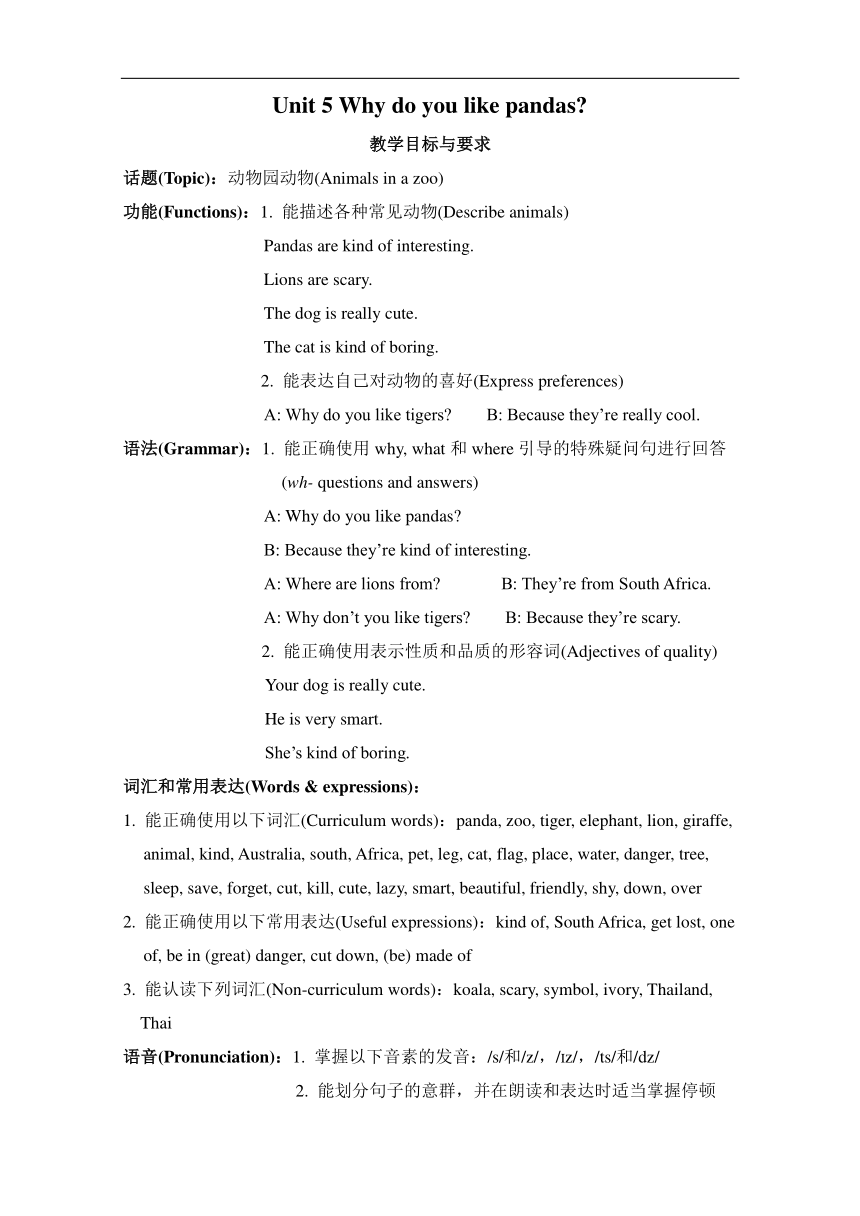
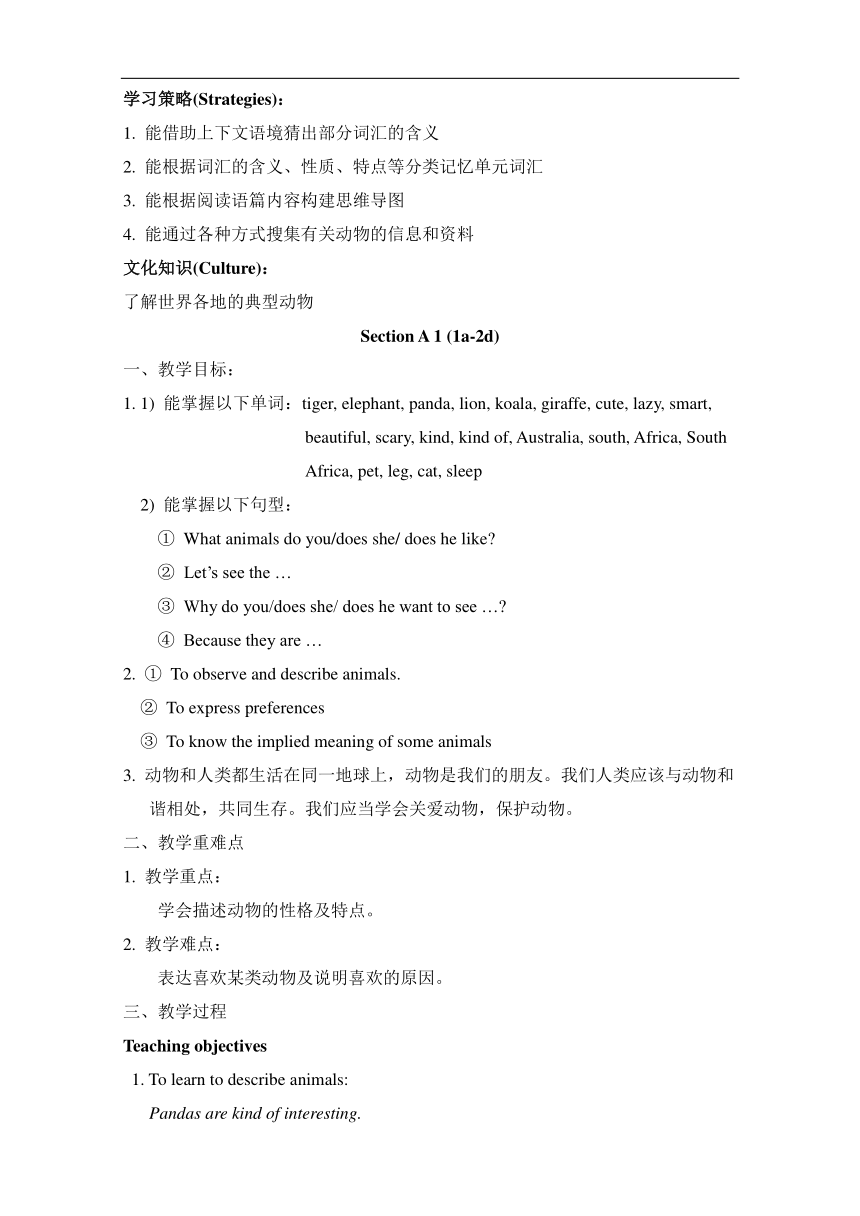
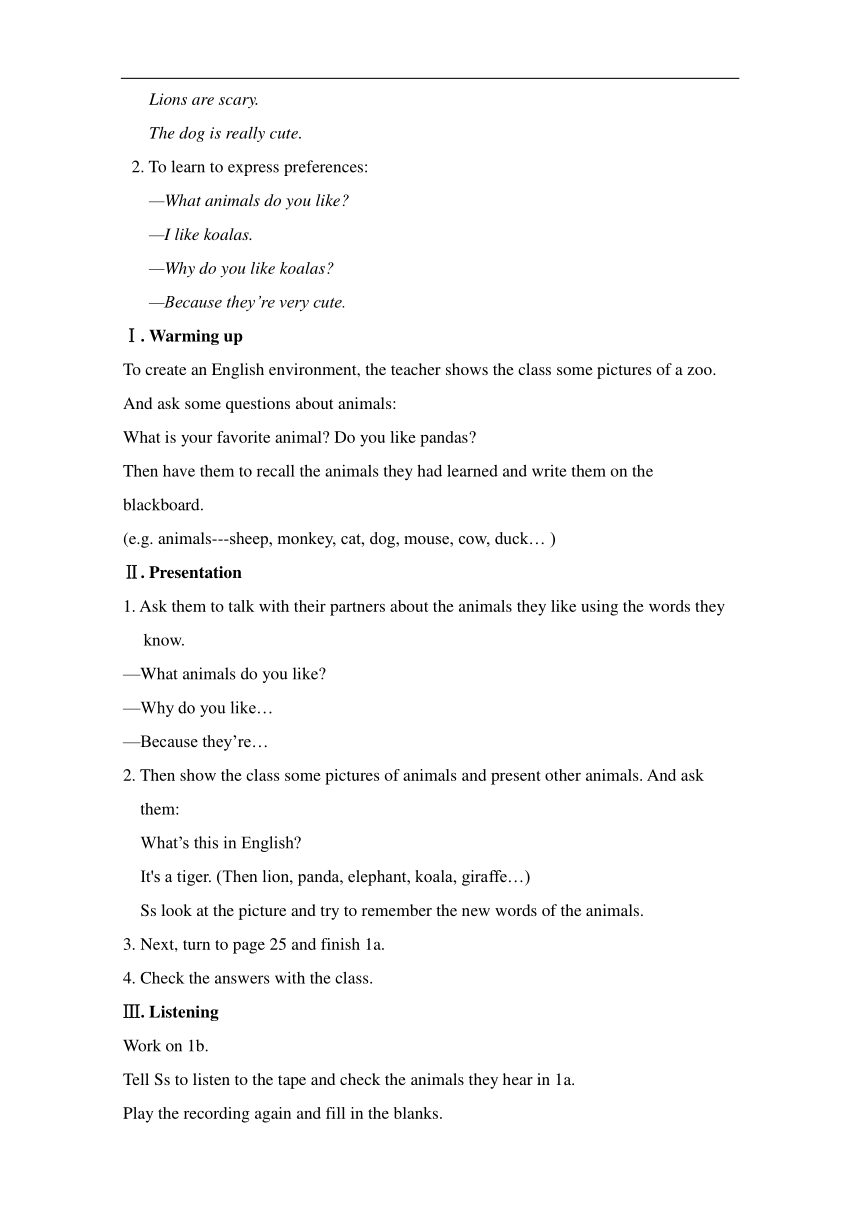
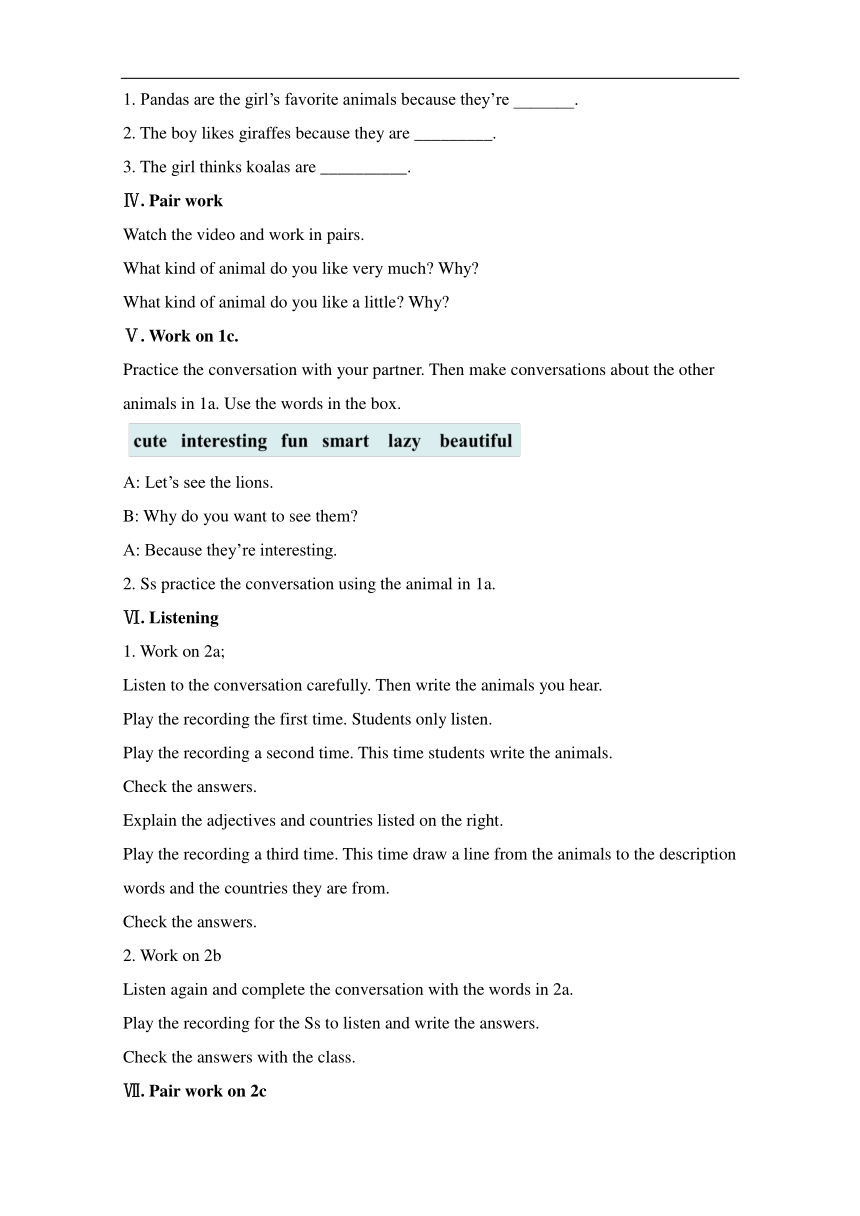
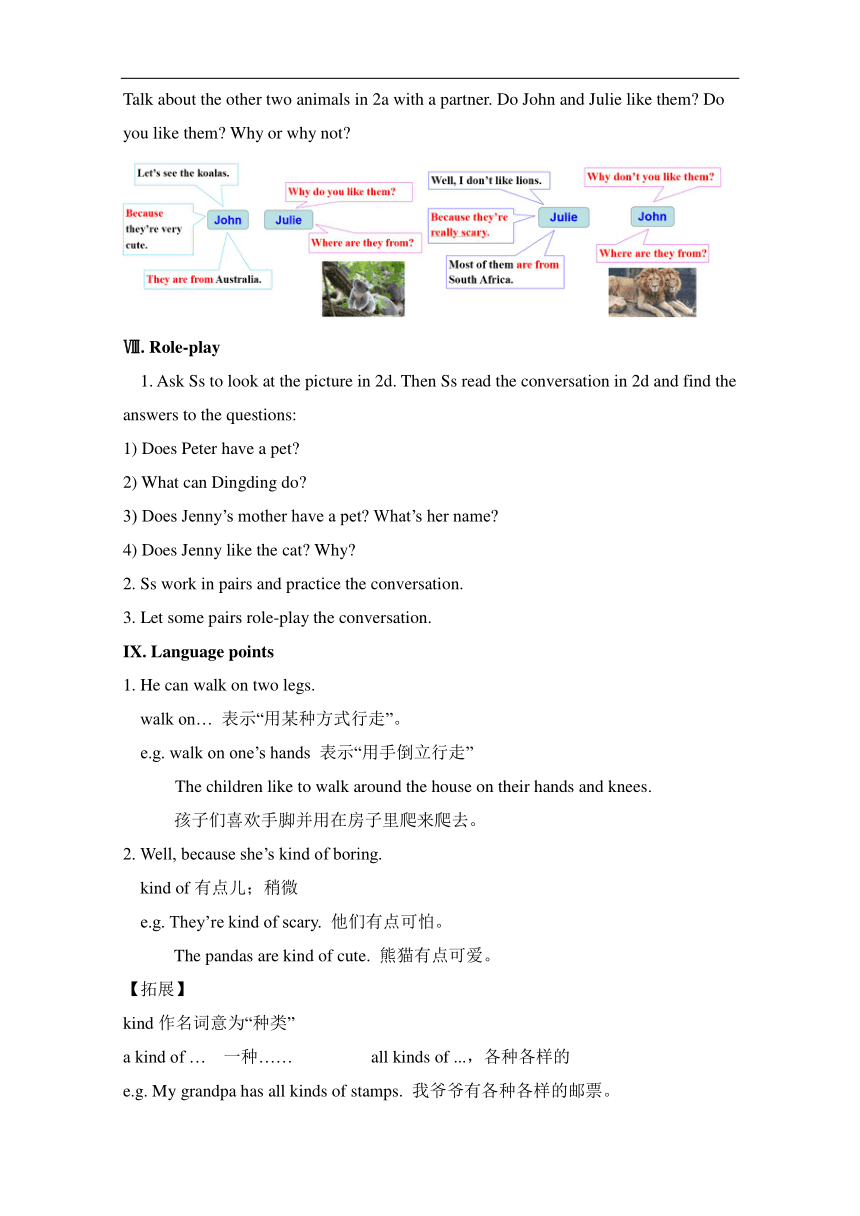
 资源预览
资源预览




